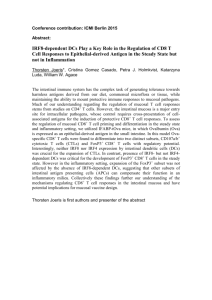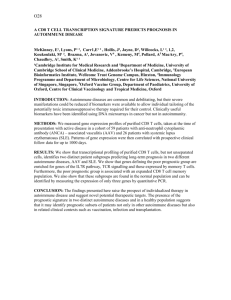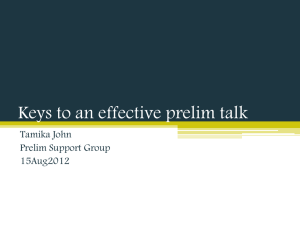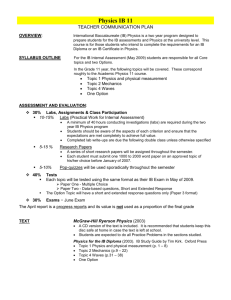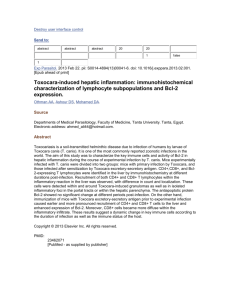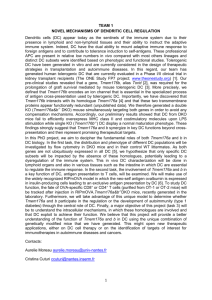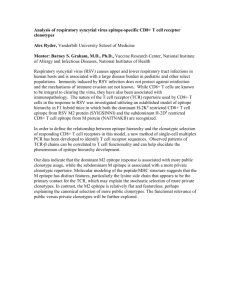Document 10953382
advertisement
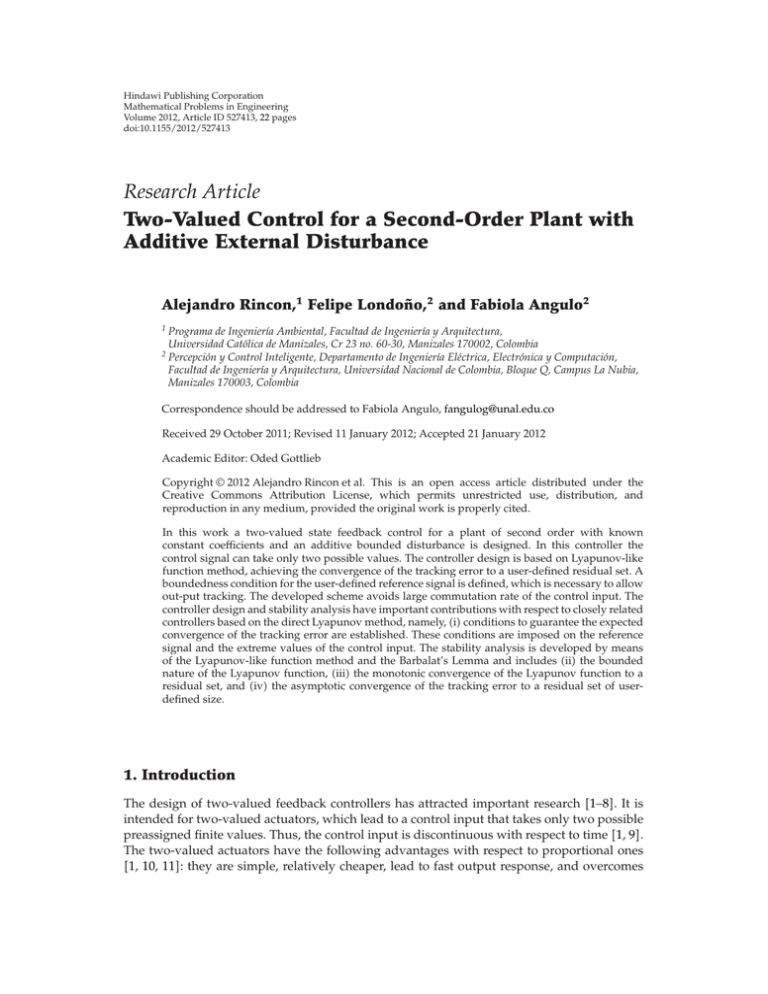
Hindawi Publishing Corporation
Mathematical Problems in Engineering
Volume 2012, Article ID 527413, 22 pages
doi:10.1155/2012/527413
Research Article
Two-Valued Control for a Second-Order Plant with
Additive External Disturbance
Alejandro Rincon,1 Felipe Londoño,2 and Fabiola Angulo2
1
Programa de Ingenierı́a Ambiental, Facultad de Ingenierı́a y Arquitectura,
Universidad Católica de Manizales, Cr 23 no. 60-30, Manizales 170002, Colombia
2
Percepción y Control Inteligente, Departamento de Ingenierı́a Eléctrica, Electrónica y Computación,
Facultad de Ingenierı́a y Arquitectura, Universidad Nacional de Colombia, Bloque Q, Campus La Nubia,
Manizales 170003, Colombia
Correspondence should be addressed to Fabiola Angulo, fangulog@unal.edu.co
Received 29 October 2011; Revised 11 January 2012; Accepted 21 January 2012
Academic Editor: Oded Gottlieb
Copyright q 2012 Alejandro Rincon et al. This is an open access article distributed under the
Creative Commons Attribution License, which permits unrestricted use, distribution, and
reproduction in any medium, provided the original work is properly cited.
In this work a two-valued state feedback control for a plant of second order with known
constant coefficients and an additive bounded disturbance is designed. In this controller the
control signal can take only two possible values. The controller design is based on Lyapunov-like
function method, achieving the convergence of the tracking error to a user-defined residual set. A
boundedness condition for the user-defined reference signal is defined, which is necessary to allow
out-put tracking. The developed scheme avoids large commutation rate of the control input. The
controller design and stability analysis have important contributions with respect to closely related
controllers based on the direct Lyapunov method, namely, i conditions to guarantee the expected
convergence of the tracking error are established. These conditions are imposed on the reference
signal and the extreme values of the control input. The stability analysis is developed by means
of the Lyapunov-like function method and the Barbalat’s Lemma and includes ii the bounded
nature of the Lyapunov function, iii the monotonic convergence of the Lyapunov function to a
residual set, and iv the asymptotic convergence of the tracking error to a residual set of userdefined size.
1. Introduction
The design of two-valued feedback controllers has attracted important research 1–8. It is
intended for two-valued actuators, which lead to a control input that takes only two possible
preassigned finite values. Thus, the control input is discontinuous with respect to time 1, 9.
The two-valued actuators have the following advantages with respect to proportional ones
1, 10, 11: they are simple, relatively cheaper, lead to fast output response, and overcomes
2
Mathematical Problems in Engineering
the issue of actuator static gain. The electrical kiln 5, hydrogel valves 12, the compressor
6, 13, the satellite antenna 2, page 25 are some systems with two-value actuators.
A basic method for two-valued control is the relay feedback with fixed hysteresis band.
The aim of the hysteresis is to avoid high commutation rate of the control input, what is
known as input chattering 10, 13 and may lead to high power consumption and wear of
mechanical components cf. 5, 6. The width of the hysteresis band determines the commutation rate of the control signal and the size of the residual set to which the output error converges. The width has to be chosen to obtain a trade-off between commutation rate and size
of the residual set, because one fact improves at the expense of the other 6. An improper
designed relay feedback may lead to overshoot, large amplitude oscillation of the output, or
large settling time cf. 10, 13. These can be overcomed by two-valued control based on
the direct Lyapunov method, as shown in 1. In that paper the authors consider a single input single output SISO linear plant in controllable form, with time varying coefficients and
additive disturbances. They ensure the convergence of the tracking error to a residual set
whose size is user defined. They show that large commutation rate is avoided if the initial values of the tracking error and its time derivative are such that the initial value of the Lyapunov function is inside a target region of user defined size.
In the case of input output stable plants with fixed preset values of the control input extremes, a two-valued input implies the following: i the output remains inside some
bounded region, regardless the controller, ii a user defined trajectory with periodic behavior
and large frequency or large magnitude cannot be reached by the system output. The
suitability of the frequency and magnitude of the user defined trajectory depends on the
extreme values of the control input, and the plant model coefficients, as it will show in this
work. Nevertheless, as far as we know, there is not a condition that indicates such suitability, in the literature on finite-valued control based on the direct Lyapunov method. In this
work such condition is established. The controller design and stability analysis have important contributions with respect to closely related controllers based on the direct Lyapunov
method, namely, i conditions to guarantee the expected convergence of the tracking error
are established. These conditions are imposed on the reference signal and the extreme values
of the control input. The stability analysis is developed by means of the Lyapunov-like
function method and the Barbalat’s Lemma and includes ii the bounded nature of the
Lyapunov function, iii the monotonic convergence of the Lyapunov function to a residual
set, and iv the asymptotic convergence of the tracking error to a residual set of user defined
size.
The work is only valid for a second-order plant with constant coefficients and an
unknown external disturbance with known upper bounds. Upper bounds can be known from
previous modelling tasks. A controller for the plant is developed, the controller is based on
the direct Lyapunov method, ensuring the convergence of the tracking error to a residual
set whose size are user defined. The work is organized as follows. In Section 2 the plant
model and the goal of the control design is detailed. In Section 3 the condition that indicates
if the desired output is suitable to achieve tracking is established. In addition, a preliminary
rough control law, which achieves the convergence of the tracking error to a residual set
whose size is user defined is formulated. Nevertheless, it may lead to large commutation rate
of the control input. This will remedy in subsequent sections. In Section 4 the control law
to avoid large commutation rate of the control input is formulated. In Sections 5 and 6 the
boundedness of the closed loop signals and the convergence of the tracking error are proven.
In Section 7 numerical simulation is presented. Finally, in Sections 8 and 9 discussion and
conclusions are presented.
Mathematical Problems in Engineering
3
2. Problem Statement
The plant, the reference model, and the state goal of the control design are detailed in this
section. Consider the following second-order plant systems analyzed with this model can be
found in 14–16
ÿ −a1 ẏ − ao y bu d,
u ∈ {umn , umx },
umx > umn ,
2.1
2.2
where yt ∈ R is the system output, ut ∈ R is the input, ao , a1 , b are plant coefficients,
being b the control gain, and d is an uncertain term that may result from modelling error or
an external disturbance. Let us consider the following assumptions.
Ai The coefficients ao , a1 , b are constant, known, and positive. Aii The signals y,
ẏ are available for measurement. Aiii The values of umn , umx are constant, user defined,
satisfy umx > umn , and are not restricted to positive values. Aiv The uncertainty d is time
varying and satisfies either
i |d| ≤ μo , μo > 0, where μo is a known positive constant, or ii d μo , μo 0.
2.3
Now, the control goal can be established. Let
et yt − yd t,
2.4
ÿd −am1 ẏd − amo yd amo r,
2.5
Ωe {e ∈ R : |e| ≤ Cbe },
2.6
where am1 , amo are positive constant of the user choice, the command signal r is bounded
and user defined, yd is the desired output or reference signal, Cbe is a positive constant, user
defined. It is important that the initial conditions yd to , ẏd to be chosen such that the initial
value of the Lyapunov function be inside the target set, to avoid large commutation rate see
1. This requirement is included in the control scheme. The aim of the reference model 2.5
is to provide an adequate nature of yd and ẏd , such that the control input can induce tracking
while large input commutation rate is avoided.
The objective of the control design is to formulate a control law for the control input
u, provided the plant model 2.1, subject to assumptions Ai to Aiv, such that Gi the
tracking error et converges asymptotically to the residual set Ωe , Gii large commutation
rate of the control input is avoided. Other goal of the control design is to develop a condition
that indicates if a given desired output is suitable to achieve tracking.
3. A Preliminary Rough Control Law
In this section, a preliminary control law for the control input u, provided by the plant 2.1,
subject to assumptions Ai to Aiv is developed. The main contribution is that the tracking
error asymptotically converges to Ωe , being Ωe defined in 2.6. The Lyapunov-like function
method, which is commonly used to design robust controllers for plants with continuous
4
Mathematical Problems in Engineering
control inputs is used. A preliminary control law is developed. This control does not prevent
large commutation rate but will be improved in subsequent sections.
Subtracting ÿd from both sides of 2.1
ÿ − ÿd −a1 ẏ − ao y bu − ÿd d,
ÿ − ÿd −a1 ẏ − ẏd − ao y − yd
3.1
− a1 ẏd − ao yd bu − ÿd d,
since the first- and second-time derivatives of the tracking error are ė ẏ − ẏd , ë ÿ − ÿd , it
is obtained:
ë −a1 ė − ao e bu − ÿd − a1 ẏd − ao yd d
−a1 ė − ao e bv,
v u−
ÿd a1 ẏd ao yd d
.
b
b
3.2
3.3
The term v is introduced with two objectives. The first one is for notational simplicity, and
the second one is to simplify the design of a control law that overcomes the effect of yd and
its time derivatives. Equation 3.2 can be rewritten as
ẋ1 x2 ,
3.4
ẋ2 −a1 x2 − ao x1 bv,
x1 e,
x2 ė.
3.5
Consider the following Lyapunov function:
1 2 1 2
S x1 ,
2ao
2
xt x1 t x2 t ,
3.6
Sxt a1 x1 x2 .
3.8
V xt 3.7
The time derivative of V along trajectory 3.4 is
V̇ 1
SṠ x1 ẋ1
ao
1
Sa1 x2 ẋ2 x1 x2
ao
−a1 x12
3.9
b
Sv
ao
−c1 a1 x12 − 1 − c1 a1 x12 b
Sv,
ao
Mathematical Problems in Engineering
5
where v is defined in 3.3, whereas c1 is constant, user defined, and satisfies c1 ∈ 0, 1. Constant c1 is introduced in 3.9 with the objective to change the commutation rate. A complete
expression of the improved controller is given in 4.9 and it shows explicitly the usefulness
of this constant. The above equation suggests that if the control law for u is properly defined,
then
− 1 − c1 a1 x12 ⇒ V̇ ≤
b
Sv ≤ 0
ao
3.10
−c1 a1 x12 .
The condition V̇ ≤ −c1 a1 x12 implies that the tracking error converges asymptotically to a small
value. To find a rough control law that achieves this, the term Sv can be written as
ÿd a1 ẏd ao yd
d
S
Sv −S −u b
b
ÿd a1 ẏd ao yd
d
−|S| −u sgnS sgnS S.
b
b
3.11
From assumption Aiv it follows that d/bS ≤ μo /b|S|. Substituting this into 3.11, it is
obtained:
ÿd a1 ẏd ao yd
μo
Sv ≤ −|S| −u sgnS sgnS |S|,
b
b
μo
ÿd a1 ẏd ao yd
sgnS −
.
Sv ≤ −|S| −u sgnS b
b
3.12
If the term in parenthesis is positive, then Sv ≤ 0. It can be achieved with the following rule:
u
⎧
⎨u − δ sgnS
if S /0
⎩does not change
if S 0,
3.13
where
u
1
umn umx ,
2
δ
1
umx − umn ,
2
3.14
substituting 3.13 into 3.12, it is obtained
μo
ÿd a1 ẏd ao yd
−u −
,
Sv ≤ −|S| δ sgnS
b
b
the following property is needed.
3.15
6
Mathematical Problems in Engineering
Proposition 3.1. If
umn μo ÿd a1 ẏd ao yd
μo
≤
≤ umx −
b
b
b
∀t ≥ to ,
3.16
then
δ sgnS
ÿd a1 ẏd ao yd
μo
−u −
≥ 0 ∀t ≥ to ,
b
b
3.17
the proof is presented in Appendix A.
Remark 3.2. A given desired output yd with excessive magnitude or excessive frequency
would not fulfill 3.16. Nevertheless, since it is assumed that the coefficients ao , a1 , b, umn ,
umx are constant, and the plant model 2.1 is usually predefined, condition 3.16 can be
fulfilled by modifying the values of amo , am1 , and r of the reference model 2.5. This can be
carried out by means of simulation.
Remark 3.3. Condition 3.16 implies that the value of umn is low enough and the value of umx
is high enough such that the control input can drive the output y towards the desired output
yd .
Substituting 3.17 in 3.15, it follows Sv ≤ 0 for S /
0, and from 3.9 it follows that
V̇ ≤ −a1 x12 ≤ −c1 a1 x12 . If S 0, thus Sv 0 and from 3.9 it follows that V̇ ≤ −c1 a1 x12 .
Therefore, V̇ ≤ −c1 a1 x12 if rule 3.13 is used. These results are summarized in the following
Theorem.
Theorem 3.4. Consider the plant model 2.1 subject to assumptions (Ai) to (Aiv), the Lyapunov
function V xt defined in 3.6 and the signal S defined in 3.8. If condition 3.16 is fulfilled, and
rule 3.13 is used, then
V̇ ≤ −c1 a1 x12 .
3.18
Therefore, the control law 3.13 implies the convergence of the tracking error x1 to a
small value.
Remark 3.5. The control rule 3.13 operates as follows. For t to , if Sxto 0 the control
input may take any on the values umn , umx . If Sxto / 0, the control input is defined by
u u − δ sgnSxto for t to . The control input u retains its initial value until the signal
sgnSxt changes its value with respect to sgnSto . Then, u changes according to the
rule u u − δ sgnS. The input u retains such value until the value of sgnS changes again,
so that u changes according to u u − δ sgnS. This is repeated successively. If S 0 in some
instant time, the input u does not change its value.
Remark 3.6. According to 2, 7, the use of discontinuous control law may lead to i
loss of trajectory unicity, ii sliding motion of trajectories along the discontinuity surface,
what may imply chattering see 2, pages 282-283, and iii input chattering, which is an
undesired large commutation rate component in the control input see 2, page 292. Large
Mathematical Problems in Engineering
7
commutation rate may lead to high power consumption and wear of mechanical components
cf. 5, 6. A rigorous design of a direct Lyapunov method should include the following tasks
cf. 7: i ensure that trajectory unicity is preserved, ii develop the Filippov’s construction
for the case that sliding motion occurs, in order to avoid chattering. In the case under study,
there may be sliding motion of the states x1 , x2 along the surface S 0. In 1 sliding motion
for a closely related control scheme is illustrated. Thus, the control scheme 3.13 may lead to
undesired large commutation rate in the input u when S takes on small values, so that goal
Gii is not fulfilled. If large commutation rate is not a problem, sliding mode control could
be used as an alternative approach 17–19.
In next section, the control law given by 3.13 is improved.
4. The Final Control Law
In previous section it was formulated a control law that achieves adequate convergence of
the tracking error but leads to large commutation rate. In this section, the convergence of
the quadratic function V to a small residual set and adequate initial values of the Lyapunov
function V are considered and the large commutation rate is overcome.
In 1, 20 authors show that the convergence of Lyapunov function to a target manifold
leads to the convergence of tracking error to a residual set of user defined size. From 3.6 it
follows that if V converges to some small residual set of adequate size, then the tracking error
e converges to the residual set Ωe defined in 2.6.
Proposition 4.1. Consider the function V defined in 3.6, the tracking error e defined in 2.4 and
the set Ωe defined in 2.6. Let
Ωv {V xt ∈ R : V xt ≤ Cbv },
a21
1
2
.
Cbv Cbe max 1,
2
ao
4.1
4.2
The convergence of V and e are related as follows: If V converges to Ωv , then e converges to Ωe , where
Cbe is a positive constant defined by the user. The proof is presented in Appendix B.
Therefore, it is necessary to formulate a control law for u that ensures:
V̇ ≤ −c1 a1 x12
for V ≥ Cbv .
4.3
so as to achieve the expected convergence of the tracking error. Indeed, if the above condition
is ensured, then: i V converges asymptotically to Ωv , where Ωv {V x ∈ R : V x ≤ Cbv },
ii if in addition V reaches Ωv for some instant, V remains inside thereafter, iii the tracking
error e converges asymptotically to Ωe . Control scheme 3.13 can achieve condition 4.3 as
mentioned in Theorem 3.4. does not involve the case V < Cbv , then the control input u can
take arbitrary values for V < Cbv without disrupting the convergence of e to Ωe . As in 1, it
8
Mathematical Problems in Engineering
is advisable to stop the commutation of u when V < Cbv , in order to avoid large commutation
rate:
u
⎧
⎨u − δ sgnS
if V ≥ Cbv , S /
0,
⎩stops commutation
otherwise.
4.4
This control rule implies that large commutation rate is prevented for V ≤ Cbv , but not
for V > Cbv . Indeed, there may be sliding motion of the trajectories along S 0 if V > Cbv ,
as occurs in 1. A possible remedy is to impose a boundary layer around S 0 for V > Cbv .
From 4.3 it follows that commutation can be stopped when the condition V̇ ≤ −c1 a1 x12 is
satisfied for V ≥ Cbv under arbitrary values of the control input u. The restrictions over x1
and x2 ensuring the above condition will be determined at the following. Expression 3.9
can be rewritten as
V̇ ≤ −c1 a1 x12 − 1 − c1 a1 x12 b
|S||v|.
ao
4.5
The requirement 3.16 implies that |v| is bounded by a constant, as the following proposition
shows.
Proposition 4.2. The signal V defined in 3.3 satisfies
|v| ≤ umx − umn .
4.6
The proof is presented in Appendix C.
Substituting 4.6 into 4.5 yields
V̇ ≤ −c1 a1 x12 − 1 − c1 a1 x12 b
|S||umx − umn |.
ao
4.7
Therefore,
V̇ ≤ −c1 a1 x12
for V ≥ Cbv ,
if − 1 − c1 a1 x12 b
|S||umx − umn | ≤ 0,
ao
4.8
where −1 − c1 a1 x12 b/ao |S||umx − umn | ≤ 0 defines a boundary layer around S 0 in the
x1 − x2 state space, for V > Cbv . The control law can take advantage of the above expression.
Equation 4.8 indicates that it is possible to turn off commutation of the control input u while
obtaining V̇ ≤ −c1 a1 x12 for V ≥ Cbv if x1 , x2 satisfy the condition therein. The control law for u
is then formulated as follows: i u follows the rule u u − δ sgnS for the case that V ≥ Cbv
Mathematical Problems in Engineering
9
and condition in 4.8 is not fulfilled, ii u follows the rule u u − δ sgnS for the case that
0, and iii u stops commutation stops cm otherwise ow. Equivalently:
V Cbv and S /
⎧
⎪
⎪
u − δ sgnS
⎪
⎪
⎨
u u − δ sgnS
⎪
⎪
⎪
⎪
⎩
stops cm
if V ≥ Cbv and − 1 − c1 if V Cbv and S /
0,
a1 x12
b
|S|umx − umn > 0,
ao
4.9
otherwise,
and for t to :
i if Sxto 0, u can take any of the values umn or umx ,
ii if V xto < Cbv , u can take any on the values umn , umx ,
0 and V xto Cbv , u takes on the value u u − δ sgnSxto ,
iii if Sxto /
iv if V xto > Cbv and − 1 − c1 a1 x12 b
|S|umx − umn > 0,
ao
u takes on the value u u − δ sgnSxto 4.10
the signals necessary for the computation of u are: u and δ 3.14, Cbv 4.2, S 3.8, e 3.5, yd
provided by 2.1, c1 is a user defined positive constant.
Remark 4.3. The control law 4.9 operates as follows. For t to , u follows 4.10. The control
input u retains its initial value until some of the conditions in 4.9 is fulfilled. At that instant
time, the control input u follows the rule u u − δ sgnS, inducing the decrease of V .
The input u retains such value until some of the conditions in 4.9 are fulfilled again. This
procedure is repeated in the same way. Condition 3.16 should be fulfilled.
Remark 4.4. Equation 4.9 indicates that the control signal u commutes as less as possible.
When the commutation stops, the control signal keeps the value acquired during previous
commutation mode. The commutation rate of the control input u does not reach excessive
values, because if S becomes zero, then u stops commutation.
Remark 4.5. The constant Cbe cannot be zero, as we explain at the following. From 4.9 it
0. A value Cbe 0 would
follows that the control input u commutes when V Cbv and S /
imply Cbv 0, as it follows from the definition 4.2. Therefore, the control input u would
commute when V 0 and S / 0. Such condition is not possible, according to definition 3.6.
If Cbe is overly small, then Cbv is also small, as it follows from the definition 4.2. Therefore,
the time that V takes to reach V Cbv is small, implying a larger commutation rate, according
to 4.9.
The discussion and simulation examples shown in 1 indicate that if condition
V xto ≤ Cbv is fulfilled, then V xt ≤ Cbv for all t ≥ to and large commutation rate is
avoided. Indeed, from definition 3.6 it follows that the condition V xto ≤ Cbv is fulfilled
10
Mathematical Problems in Engineering
if eto , ėto have adequate magnitude, or equivalently, if the distance between yd to and
yto , and distance between ẏd to and ẏto are adequate. Thus, the following control strategy is chosen:
u
⎧
⎨u − δ sgnS
if V Cbv , /
0,
⎩stops cm
otherwise.
4.11
yd to , ẏd to are chosen such that V xto ∈ Ωv , Ωv {V xt ∈ R : V xt ≤ Cbv }. For
t to , the signal control is computed as:
i if V xto < Cbv ,
0,
ii if Sxto /
u can take any on the values umn , umx ,
V xto Cbv ,
iii if Sxto 0,
V xto Cbv ,
u takes on the value u u − δ sgnSxto ,
u can take any on the values umn , umx,
4.12
Remark 4.6. The control law 4.11 operates as follows. For t to , u follows 4.12. The control
input u retains its initial value until V Cbv and S / 0. At that instant time, the control input
u follows the rule u u − δ sgnS, inducing the decrease of V . The input u retains such
0 is fulfilled again. This procedure is repeated in the same way. If
value until V Cbv and S /
V Cbv and S 0, then u does not change. Condition 3.16 should be fulfilled. Notice that
the constant c1 is not necessary to formulate the control law 4.11.
Remark 4.7. Equation 4.11 indicates that the control signal u commutes as less as possible.
When the commutation stops, the control signal keeps the value acquired during previous
commutation mode. The commutation rate of the control input u does not reach excessive
values, because if S becomes zero, then u stops commutation.
4.1. Implementation Issues
In experimental implementation could be difficult to detect the exact moment when V Cbv ,
so that it could be difficult to use the control scheme 4.11. Then, with the aim to apply the
control strategy to one system, it is possibility to use the control scheme given by 4.9 instead
of 4.11, because 4.9 includes the case V > Cbv . Other possibility is to use a threshold δV in
4.11 as follows:
u
⎧
⎨u − δ sgnS if V ∈ Cbv − δV , Cbv , S /
0,
⎩stops cm
otherwise,
4.13
where δV is a positive constant that satisfies δV < Cbv , and yd to and ẏd to are chosen such
that V xto ∈ Ωv , Ωv {V xt ∈ R : V xt ≤ Cbv }.
Mathematical Problems in Engineering
11
5. Boundedness Analysis
In this section we analyze the boundedness properties of the closed loop signals. As in 21,
the notation · ∈ L∞ is used. This notation indicates that · is bounded.
Theorem 5.1 boundedness of the closed loop signals. Consider the plant model 2.1, subject
to assumptions (Ai) to (Aiv), the tracking error e, the desired output yd and the function S provided
by 2.4, 2.5, 3.8, respectively. If condition 3.16 is fulfilled and the controller 4.9 is applied,
then the signals x1 , x2 , S remain bounded.
Proof. From 4.8 it follows that
V̇ ≤ −c1 a1 x12
−1 − c1 a1 x12 if V > Cbv ,
b
|S||umx − umn | ≤ 0.
ao
5.1
From 4.9 it follows that
u u − δ sgnS,
if V > Cbv ,
−1 − c1 a1 x12 or V Cbv ,
S/
0.
b
|S||umx − umn | > 0,
ao
5.2
b
|S||umx − umn | > 0,
ao
5.3
Therefore, it follows from Theorem 3.4 that
V̇ ≤ −c1 a1 x12 ,
if V > Cbv ,
or V Cbv ,
−1 −
c1 a1 x12
S
/ 0.
and controller 4.9 is applied. From 4.7 it follows that
V̇ ≤ −c1 a1 x12 ,
if V > Cbv ,
or V Cbv ,
−1 −
c1 a1 x12
b
|S||umx − umn | ≤ 0,
ao
5.4
S 0.
From 5.3, 5.4 it follows that
V̇ ≤ −c1 a1 x12
if V ≥ Cbv .
5.5
12
Mathematical Problems in Engineering
Since the above expression is not valid for V < Cbv , it does not lead to a straightforward proof
of the boundedness and convergence of V . In order to show that the Lyapunov function V is
bounded, a Lyapunov-like function fa fa V that satisfies
i fa ≥ 0
∀t ≥ to ,
ii V ≤ ca cb facc V ∀t ≥ to ,
5.6
iii f˙a ≤ 0 ∀t ≥ to ,
will be used, being ca , cb , cc positive constants. If fa satisfies the above three conditions, then
fa ∈ L∞ and consequently V ∈ L∞ . One example of such function is
⎧ ⎪
⎨ 1 V − Cbv 2
2
fa V ⎪
⎩0
if V ≥ Cbv ,
5.7
otherwise.
The reader is referenced to 2, page 309, 22, 23 for closely related functions. Its time
derivative is:
f˙a ∂fa
V̇ ,
∂V
⎧
∂fa ⎨V − Cbv if V ≥ Cbv ,
⎩0
∂V
otherwise,
⎧
⎨V − Cbv if V ≥ Cbv ,
⇒ f˙a ⎩0
otherwise,
5.8
5.9
since V − Cbv is positive or zero for V ≥ Cbv , it can be multiplied by 5.12 without changing
the order of the inequality:
V − Cbv V̇ ≤ −a1 x12 V − Cbv if V ≥ Cbv ,
5.10
substituting it into 5.9, it is obtained:
⎧
⎨f˙a ≤ −a1 x12 V − Cbv ≤ 0
if V ≥ Cbv ,
⎩f˙ 0
a
otherwise.
5.11
Then, fa satisfies properties 5.6,
as discussed at the following. From the definition 5.7 it
follows that fa ≥ 0, V ≤ Cbv 2fa , so that properties 5.6i and 5.6ii are satisfied. From
5.11 it follows that property 5.6iii is true, so that fa ∈ L∞ . Since 5.6ii is true, then
V ∈ L∞ . From 3.6 it follows that x1 ∈ L∞ , S ∈ L∞ , and from 3.8 it follows that x2 ∈ L∞ .
This completes the proof.
Mathematical Problems in Engineering
13
If the control law 4.11 is applied to the plant 2.1, and the initial value of the function
V is located inside the target region, then V remains inside the target region thereafter, as is
proven at the following.
Theorem 5.2 boundedness of the Lyapunov function for V ≤ V xto . Consider the plant
model 2.1, subject to assumptions (Ai) to (Aiv), the tracking error e, the desired output yd and the
function S provided by 2.4, 2.5, and 3.8, respectively. If condition 3.16 is fulfilled, the controller
4.11 is applied and V xto ≤ Cbv , then V xt ≤ Cbv for all t ≥ to , x1 ∈ L∞ , x2 ∈ L∞ .
Proof. The nature of V̇ for V Cbv must be examined considering each of the cases S 0 and
S
0 and
/ 0 separately. From Theorem 3.4 it follows that if the control law 3.13 is used, S /
V Cbv , then V̇ ≤ −a1 x12 . To show that this expression is also valid for the case when S 0
and V Cbv , 3.9 is used. From 3.9 it follows that V̇ ≤ −a1 x12 if S 0, regardless the value
of V . Consequently, if the control law 4.11 is used, S 0 and V Cbv , then V̇ ≤ −a1 x12 . So
far, it has been shown that if the control law 4.11 is used and V Cbv , then
V̇ ≤ −c1 a1 x12 ,
5.12
regardless the value of S. This implies that if V xt1 Cbv for any t1 ≥ to , then V xt1 δt ≤
V xt1 for a small value of δt . Consequently, V xt2 ≤ V xt1 for all t2 ≥ t1 . Moreover,
if V xto ≤ Cbv , then V xt ≤ Cbv for all t ≥ to . From 3.6 it follows that x1 ∈ L∞ , S ∈ L∞ ,
and from 3.8 it follows that x2 ∈ L∞ . This completes the proof.
6. Convergence of the Tracking Error
In this section it is proven that if the controller 4.11 is applied to the plant model 2.1, the
tracking error et converges to a residual set Ωe {e ∈ R : |e| ≤ Cbe }.
Equation 5.11 will be arranged into a single expression. Using
fb ⎧
⎨V − Cbv
if V ≥ Cbv ,
⎩0
otherwise.
6.1
Equation 5.11 can be rewritten as
⎧
⎨f˙a ≤ −a1 x12 fb ≤ 0
if V ≥ Cbv ,
⎩f˙ 0 −a x2 f ,
a
1 1 b
otherwise
⇒ f˙a ≤ −a1 x12 fb .
6.2
A difficulty is that dfb /dt is not continuous, as ∂fb /∂V is discontinuous at V Cbv .
Consequently, the Barbalat’s Lemma can not be applied on fb . One remedy is to express
6.2 in terms of a new function whose first derivative with respect to V is continuous. One
instance of that function is
⎧√
2
⎨ V − Cbv
fc ⎩
0
if V ≥ Cbv ,
otherwise.
6.3
14
Mathematical Problems in Engineering
The reader is referenced to 2, page 309, 22, 24, 25 for closely related functions. To express
6.2 in terms of fc , the following property is needed.
Proposition 6.1. The function 6.3 satisfies
fb ≥ fc ,
6.4
the proof is presented in Appendix D.
Substituting 6.4 into 6.2, it is obtained
f˙a ≤ −a1 x12 fb ≤ −a1 x12 fc ≤ 0.
6.5
Arranging and integrating, as in 26, 27, it is obtained
t
a1
to
x12 fc dτ ≤ fa Vo − fa V ,
6.6
Vo V xto ,
t
x12 fc dτ ≤ fa Vo ,
fa V a1
to
since fc ≥ 0, then x12 fc ∈ L1 . As in 21, · ∈ L1 is used to indicate that
t
to
|·|dτ is bounded.
Proposition 6.2. The term x12 fc satisfies: x12 fc ∈ L∞ , dx12 fc /dt ∈ L∞ . The proof is presented in
Appendix E.
In view of the above proposition and applying the Barbalat’s Lemma cf. 21, page 76,
26–28, it is obtained
lim x2 fc
t→∞ 1
0
⇒ lim x12 0
t→∞
or lim fc 0.
6.7
t→∞
If fc is the one that converges towards zero, it follows from 6.3 that V converges to Ωv ,
where Ωv {V x ∈ R : V x ≤ Cbv }. From Proposition 4.1 it follows that e converges to Ωe ,
where Ωe {e ∈ R : |e| ≤ Cbe }. The results can be summarized as follows.
Theorem 6.3 convergence of the tracking error. Consider the plant model 2.1, subject to
assumptions (Ai) to (Aiv), the tracking error e, the desired output yd and the function S provided by
2.4, 2.5, and 3.8, respectively. If condition 3.16 is fulfilled and the controller 4.11 is applied,
then e converges to Ωe , where Ωe {e ∈ R : |e| ≤ Cbe }, being Cbe a positive user defined constant.
Mathematical Problems in Engineering
15
1.5
1
0.5
0
−0.5
−1
−1.5
0
5
10
15
20
25
30
Time
Figure 1: Example 1, top horizontal line: umx −μo /b, bottom horizontal line: umn μo /b, thin line: 1/bÿd a1 ẏd ao yd .
7. Simulation Example
The aim of the following example is to show that the controller 4.11 achieves the benefits
mentioned in Theorem 6.3. To that end, assumptions Ai to Aiv of Section 2 and condition
3.16 have to fulfill. Considerations of Section 4 are taken into account. Consider the plant:
yto 0.97, ẏto 0,
ÿ −ẏ − y u d,
u ∈ {−1.2, 1.2},
2π
t
,
d 0.1 1 0.1 sin
3
7.1
|d| ≤ 0.11 ⇒ μo 0.11,
which is an example of the plant 2.1 with a1 1, ao 1, b 1, umn −1.2, umx 1.2, μo 0.11. Therefore, assumptions Ai to Aiv stated in Section 2 are fulfilled. Since ao > 1/4a21 ,
the linear part of the plant is underdamped. The aim is that y converges towards the value
r cos0.5t with an accuracy of 0.05. Thus, set Cbe 0.05 and yd is defined by means of the
second order system:
λ2r
yd p λr
2 r,
7.2
which is a special case of 2.1. V xto ≤ Cbv is fulfilled choosing yd to 1 and
ẏd to 0. By means of simulation it is possible to check that yd , ẏd , ÿd , and λr 12 satisfy
condition 3.16, as shown in Figure 1. The chosen values of λr , yd to , ẏd to imply that
yd ≈ r for all t ≥ to . Since a1 1, the signal S defined in 3.8 is then S a1 e ė e ė.
The closed loop behavior of y, e, u is shown in Figure 2, whereas the state plane is shown in
Mathematical Problems in Engineering
2
0.05
0
0
−2
e
y, yd
16
0
2
4
6
8
10
−0.05
12
0
2
4
6
8
10
12
Time
Time
a
b
2
u
0
−2
0
2
4
6
8
10
12
Time
c
Figure 2: Example 1, a output y continuous line and desired output yd dashed line; b tracking error
et; c control input u.
0.08
0.06
0.04
de/dt
0.02
0
−0.02
−0.04
−0.06
−0.08
−0.05
0
0.05
e
Figure 3: Example 1, the solid line represents V Cbv .
Figure 3. The state plane confirms that V xto ≤ Cbv , so that V xt ≤ Cbv for all t ≥ to and
u only commutes when V Cbv . The figure of the control input u and the state plane indicate that large commutation rate is avoided. This confirms the importance of choosing yd to ,
ẏd to such that V xto ≤ Cbv .
8. Discussion
The discussion presented here is only valid for the plant model 2.1, which is a model second
order with known constant coefficients and an additive disturbance. The time derivative of
the function V defined in 3.6 results in a negative semidefinite term, so that it is necessary to
use Lyapunov-like function method to prove the convergence of the tracking error. Hereafter,
some conclusions based on both stability proofs and numerical simulations are stated. In the
Mathematical Problems in Engineering
17
classical relay feedback method 10, 13 the commutation of the control input is function of
the tracking error, but it does not take into account the time derivative of the tracking error.
The developed condition 3.16 indicates wether a given desired output yd is suitable
to achieve the convergence of the tracking error e to a residual set of user defined size,
that is, Ωe , for the plant 2.1. For any instance of the plant 2.1, one may modify the
coefficients of the reference model 2.5 to satisfy condition 3.16, by means of trial and
error. This procedure does not involve the output y, nor the input u, and is previous to the
implementation of the controller.
It is important to set the initial values of the desired output and its time derivative
such that V xto ≤ Cbv . This implies that the Lyapunov function V is always located inside
the target region Ωv {V ∈ R : V ≤ Cbv }, so that it avoids convergence towards this region,
and consequently large commutation rate of the control input are avoided.
The contribution of the scheme with respect to classical relay feedback control based
on hysteresis is to ensure the convergence of the tracking error et to a residual set whose
size is user defined. The main contribution with respect to closely related control based on
the direct Lyapunov method is that the condition that the desired output yd has to fulfill in
order to achieve tracking is defined.
9. Conclusions
The controller achieves the convergence of the tracking error to a residual set of user defined
size if the desired output satisfies the formulated condition. This condition uses the upper
bound of the additive disturbance, as in a basic nonadaptive robust controller. It allows us
to develop a rigorous proof of the tracking error convergence to a residual set that is user
defined, by means of the Lyapunov-like function. If the initial values of the desired output
and its time derivative are properly defined, the Lyapunov function is located inside a target
region at initial time and thereafter. In this case, the control input only commutes when the
Lyapunov function reaches the boundary.
Appendices
A. Proof of Proposition 3.1
From 3.16 it follows that
u−δ
μo ÿd a1 ẏd ao yd
μo
≤
≤uδ− ,
b
b
b
A.1
subtracting u:
−δ μo
μo ÿd a1 ẏd ao yd
≤
−u≤δ− .
b
b
b
A.2
18
Mathematical Problems in Engineering
Thus,
μo
ÿd a1 ẏd ao yd
−u −
≥ 0,
b
b
ÿd a1 ẏd ao yd
μo
δ
−u −
≥ 0.
b
b
A.3
ÿd a1 ẏd ao yd
μo
−u −
≥ 0.
δ sgnS
b
b
A.4
δ−
Thus,
This completes the proof.
B. Proof of Proposition 4.1
Proposition 4.1 will be proven by finding the value of a positive constant Cb∗ such that:
Ωv V ∈ R : V ≤ Cb∗ ,
If V converges to Ωv ,
then e converges to Ωe ,
Ωe {e ∈ R : |e| ≤ Cbe }.
B.1
The value of Cb∗ will be fond out by means of two different ways. On the one hand, it follows
from 3.6 and the definition of Ωv in B.1 that
1 2
S ≤ V, ⇒ |S| ≤ 2ao V
2ao
⇒ if V converges to Ωv , then S converges to Ωs ,
Ωs S : |S| ≤ 2ao Cb∗ .
B.2
From the definitions 3.8, 3.5, S can be expressed as a linear function of e, ė: S a1 e ė.
Thus, e in terms of S is given by
e
1
S.
p a1
B.3
In view of this equation and according to 2, page 279-280, and 29, it follows:
If S converges asymptotically to Ωs ,
then e converges asymptotically to Ωe ,
B.4
where
Ωs S : |S| ≤ 2ao Cb∗ ,
Ωe e : |e| ≤
1 ∗
2ao Cb .
a1
B.5
Mathematical Problems in Engineering
19
This and B.2 imply:
if V converges to Ωv , then e converges to Ωe ,
1
2ao Cb∗ .
ca Ωe {e : |e| ≤ ca },
a1
B.6
See 2, page 279-280 and 29 for closely related results. The value of Cb∗ that leads to ca Cbe
2
has been found, thus B.1 is satisfied. This value is Cb∗ a21 Cbe
/2ao , which is a first value
∗
of Cb . On the other hand, it follows from 3.6 that
√
1 2
e ≤ V ⇒ |e| ≤ 2V .
2
B.7
This and the definition of Ωv in B.1 imply
if V converges to Ωv , then e converges to Ωe ,
Ωe {e : |e| ≤ cc },
cc 2Cb∗ .
B.8
Now, the value of Cb∗ that leads to cc Cbe has been found out so that B.1 is satisfied. This
2
, which is a second value of Cb∗ . Since both values of Cb∗ are valid, then
value is Cb∗ 1/2Cbe
Cbv can be defined as the maximum:
Cbv
a2 C2 C2
max 1 be , be
2ao
2
a21
max
,1
2
ao
2
Cbe
B.9
This completes the proof.
C. Proof of Proposition 4.2
From 2.2 and 3.16 it follows that
−u ≤ −umn ,
C.1
−u ≥ −umx ,
C.2
ÿd a1 ẏd ao yd μo
≤ umx ,
b
b
C.3
ÿd a1 ẏd ao yd μo
−
≥ umn .
b
b
C.4
20
Mathematical Problems in Engineering
From C.3, C.4, 2.3 it follows that
ÿd a1 ẏd ao yd d ÿd a1 ẏd ao yd μo
− ≤
≤ umx ,
b
b
b
b
C.5
ÿd a1 ẏd ao yd d ÿd a1 ẏd ao yd μo
− ≥
−
≥ umn ,
b
b
b
b
C.6
combining C.1 with C.5 and C.2 with C.6, and using definition 3.3, yields
ÿ a1 ẏd ao yd d
− − u ≤ umx − umn ,
b
b
−v ÿ a1 ẏd ao yd d
− − u ≥ umn − umx ,
−v b
b
C.7
combining the above equations yields:
− umx − umn ≤ −v ≤ umx − umn ,
C.8
⇒ |−v| ≤ umx − umn ,
|v| ≤ umx − umn .
This completes the proof.
D. Proof of Proposition 6.1
The squared term of 6.3 in terms of V can be expressed as
√
If V > Cbv , then
√
V >
√
V−
Cbv
2
√
V − 2 Cbv V Cbv .
D.1
√
Cbv , and − V < − Cbv . Using this in D.1, it is obtained
V−
√
Cbv
V−
2
1/2 1/2
< V − 2Cbv
Cbv Cbv
Cbv
2
< V − Cbv
if V > Cbv .
D.2
if V > Cbv .
From this property and definitions 6.3, 6.1, it is obtained fc ≤ fb . This completes the proof.
Mathematical Problems in Engineering
21
E. Proof of Proposition 6.2
From the definition 6.3 and V ∈ L∞ , it follows fc ∈ L∞ . Since x1 ∈ L∞ , then x12 fc ∈ L∞ . This
completes the proof of the first part of Proposition 6.2. The time derivative of x12 fc is
dx12 fc
2x1 ẋ1 fc x12 f˙c ,
dt
f˙c ∂fc
V̇ .
∂V
E.1
E.2
Equation 6.3 is used to compute ∂fc /∂V :
⎧√
⎪
V − Cbv
⎨
∂fc
√
V
∂V ⎪
⎩0
if V ≥ Cbv ,
E.3
otherwise.
Since V ∈ L∞ , then the above equation indicates that ∂fc /∂V ∈ L∞ . Since x1 ∈ L∞ , x2 ∈ L∞ ,
S ∈ L∞ , then 3.9 indicates that V̇ ∈ L∞ . Thus, E.2 indicates that f˙c ∈ L∞ , whereas E.1
indicates that dx12 fc /dt ∈ L∞ . This completes the proof.
References
1 F. Calabrese and G. Celentano, “Multi-valued robust control technique for uncertain systems,” in Proceedings of the 47th IEEE Conference on Decision and Control, pp. 2232–2237, Cancun, Mexico, December
2008.
2 J. J. E. Slotine and W. Li, Applied Nonlinear Control, Prentice Hall, Englewood Cliffs, NJ, USA, 1991.
3 Z.-P. Jiang and D. J. Hill, “A robust adaptive backstepping scheme for nonlinear systems with unmodeled dynamics,” IEEE Transactions on Automatic Control, vol. 44, no. 9, pp. 1705–1711, 1999.
4 Y. Hong and B. Yao, “A globally stable saturated desired compensation adaptive robust control for
linear motor systems with comparative experiments,” Automatica, vol. 43, no. 10, pp. 1840–1848, 2007.
5 A. Leva, L. Piroddi, M. Di Felice, A. Boer, and R. Paganini, “Adaptive relay-based control of household freezers with on-off actuators,” Control Engineering Practice, vol. 18, no. 1, pp. 94–102, 2010.
6 M. D. Felice, L. Piroddi, A. Leva, and A. Boer, “Adaptive temperature control of a household
refrigerator,” in Proceedings of the American Control Conference (ACC ’09), pp. 889–894, St. Louis, Mo,
USA, June 2009.
7 M. M. Polycarpou and P. A. Ioannou, “On the existence and uniqueness of solutions in adaptive control systems,” IEEE Transactions on Automatic Control, vol. 38, no. 3, pp. 474–479, 1993.
8 M. Berenguel, F. Rodriguez, F. Acien, and J. Garcia, “Model predictive control of pH in tubular
photobioreactors,” Journal of Process Control, vol. 14, no. 4, pp. 377–387, 2004.
9 F. Calabrese and G. Celentano, “Embedded multi-valued control for ceramic manufacturing,” IEEE
Transactions on Industrial Electronics, vol. 58, no. 3, pp. 762–769, 2011.
10 L. Yu and T. N. Chang, “Zero vibration onoff position control of dual solenoid actuator,” IEEE Transactions on Industrial Electronics, vol. 57, no. 7, Article ID 5332329, pp. 2519–2526, 2010.
11 W. J. Kim and A. Sadighi, “Design and relay-based control of a novel linear magnetostrictive motor,”
in Proceedings of the American Control Conference (ACC ’09), pp. 3482–3487, St. Louis, Mo, USA, June
2009.
12 V. Bazargan and B. Stoeber, “A thermally actuated microfluidic relay valve,” in Proceedings of the 15th
International Conference on Solid-State Sensors, Actuators and Microsystems (TRANSDUCERS ’09), pp.
1289–1292, Denver, Colo, USA, June 2009.
22
Mathematical Problems in Engineering
13 B. Li and A. G. Alleyne, “Optimal on-off control of an air conditioning and refrigeration system,” in
Proceedings of the American Control Conference (ACC ’10), pp. 5892–5897, Baltimore, Md, USA, July 2010.
14 J. Wang, L. Rong, and Y. Liu, “A robust proportional controller for AQM based on optimized secondorder system model,” Computer Communications, vol. 31, no. 10, pp. 2468–2477, 2008.
15 E. B. Lee and J. C. Luo, “A closed analytic form for the time maximum disturbance isochrones of
second-order linear systems,” Systems & Control Letters, vol. 40, no. 4, pp. 229–245, 2000.
16 L. Premalatha and C. Ravichandran, “Reduction of Electromagnetic Interference in DC-DC Con- verter using Chaos,” in Proceedings of the International Conference on Emerging Trends in Electrical and Computer Technology (ICETECT ’11), pp. 236–239, Tamil Nadu, March 2011.
17 N. Luo and M. de la Sen, “State feedback sliding mode control of a class of uncertain time delay systems,” IEE Proceedings D, vol. 140, no. 4, pp. 261–274, 1993.
18 D. Chen and W. Zhang, “Sliding mode control of uncertain neutral stochastic systems with multiple
delays,” Mathematical Problems in Engineering, vol. 2008, Article ID 761342, 9 pages, 2008.
19 N. Luo, J. Rodellar, M. De la Sen, and J. Vehi, “Output feedback sliding mode control of base isolated
structures,” Journal of the Franklin Institute, vol. 337, no. 5, pp. 555–577, 2000.
20 J. T. Moura and N. Olgac, “Robust Lyapunov control with perturbation estimation,” IEE Proceedings
Control Theory and Applications, vol. 145, no. 3, pp. 307–315, 1998.
21 P. A. Ioannou and J. Sun, Robust Adaptive Control, Prentice-Hall PTR, Upper Saddle River, NJ, USA,
1996.
22 J. Zhou, C. Zhang, and C. Wen, “Robust adaptive output control of uncertain nonlinear plants with
unknown backlash nonlinearity,” IEEE Transactions on Automatic Control, vol. 52, no. 3, pp. 503–509,
2007.
23 Y. Feng, H. Hong, X. Chen, and C. Y. Su, “Robust adaptive controller design for a class of nonlinear
systems preceded by generalized Prandtl-Ishlinskii hysteresis representation,” in Proceedings of the
7th World Congress on Intelligent Control and Automation (WCICA ’08), pp. 382–387, Chongqing, China,
June 2008.
24 J. Zhou, C. Wen, and Y. Zhang, “Adaptive output control of nonlinear systems with uncertain deadzone nonlinearity,” IEEE Transactions on Automatic Control, vol. 51, no. 3, pp. 504–511, 2006.
25 C.-Y. Su, Y. Feng, H. Hong, and X. Chen, “Adaptive control of system involving complex hysteretic
nonlinearities: a generalised Prandtl-Ishlinskii modelling approach,” International Journal of Control,
vol. 82, no. 10, pp. 1786–1793, 2009.
26 S.-H. Huh and Z. Bien, “Robust sliding mode control of a robot manipulator based on variable structure-model reference adaptive control approach,” IET Control Theory & Applications, vol. 1, no. 5, pp.
1355–1363, 2007.
27 J. Fei, “Robust adaptive vibration tracking control for a micro-electro-mechanical systems vibratory
gyroscope with bound estimation,” IET Control Theory and Applications, vol. 4, no. 6, pp. 1019–1026,
2010.
28 Q. Hu, “Robust adaptive sliding-mode fault-tolerant control with L 2 -gain performance for flexible
spacecraft using redundant reaction wheels,” IET Control Theory & Applications, vol. 4, no. 6, pp. 1055–
1070, 2010.
29 Q. Wang and C.-Y. Su, “Robust adaptive control of a class of nonlinear systems including actuator hysteresis with Prandtl-Ishlinskii presentations,” Automatica, vol. 42, no. 5, pp. 859–867, 2006.
Advances in
Operations Research
Hindawi Publishing Corporation
http://www.hindawi.com
Volume 2014
Advances in
Decision Sciences
Hindawi Publishing Corporation
http://www.hindawi.com
Volume 2014
Mathematical Problems
in Engineering
Hindawi Publishing Corporation
http://www.hindawi.com
Volume 2014
Journal of
Algebra
Hindawi Publishing Corporation
http://www.hindawi.com
Probability and Statistics
Volume 2014
The Scientific
World Journal
Hindawi Publishing Corporation
http://www.hindawi.com
Hindawi Publishing Corporation
http://www.hindawi.com
Volume 2014
International Journal of
Differential Equations
Hindawi Publishing Corporation
http://www.hindawi.com
Volume 2014
Volume 2014
Submit your manuscripts at
http://www.hindawi.com
International Journal of
Advances in
Combinatorics
Hindawi Publishing Corporation
http://www.hindawi.com
Mathematical Physics
Hindawi Publishing Corporation
http://www.hindawi.com
Volume 2014
Journal of
Complex Analysis
Hindawi Publishing Corporation
http://www.hindawi.com
Volume 2014
International
Journal of
Mathematics and
Mathematical
Sciences
Journal of
Hindawi Publishing Corporation
http://www.hindawi.com
Stochastic Analysis
Abstract and
Applied Analysis
Hindawi Publishing Corporation
http://www.hindawi.com
Hindawi Publishing Corporation
http://www.hindawi.com
International Journal of
Mathematics
Volume 2014
Volume 2014
Discrete Dynamics in
Nature and Society
Volume 2014
Volume 2014
Journal of
Journal of
Discrete Mathematics
Journal of
Volume 2014
Hindawi Publishing Corporation
http://www.hindawi.com
Applied Mathematics
Journal of
Function Spaces
Hindawi Publishing Corporation
http://www.hindawi.com
Volume 2014
Hindawi Publishing Corporation
http://www.hindawi.com
Volume 2014
Hindawi Publishing Corporation
http://www.hindawi.com
Volume 2014
Optimization
Hindawi Publishing Corporation
http://www.hindawi.com
Volume 2014
Hindawi Publishing Corporation
http://www.hindawi.com
Volume 2014
